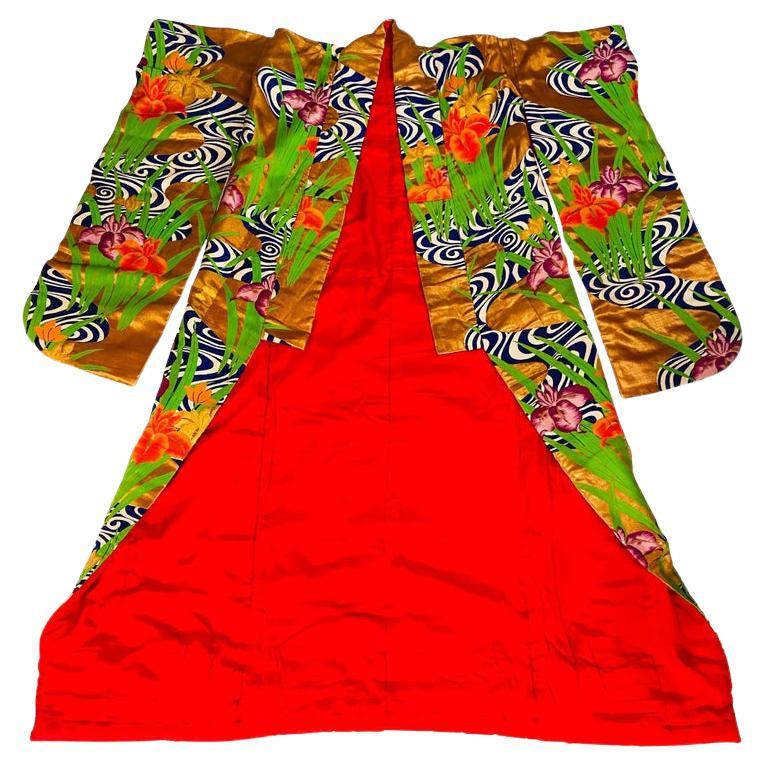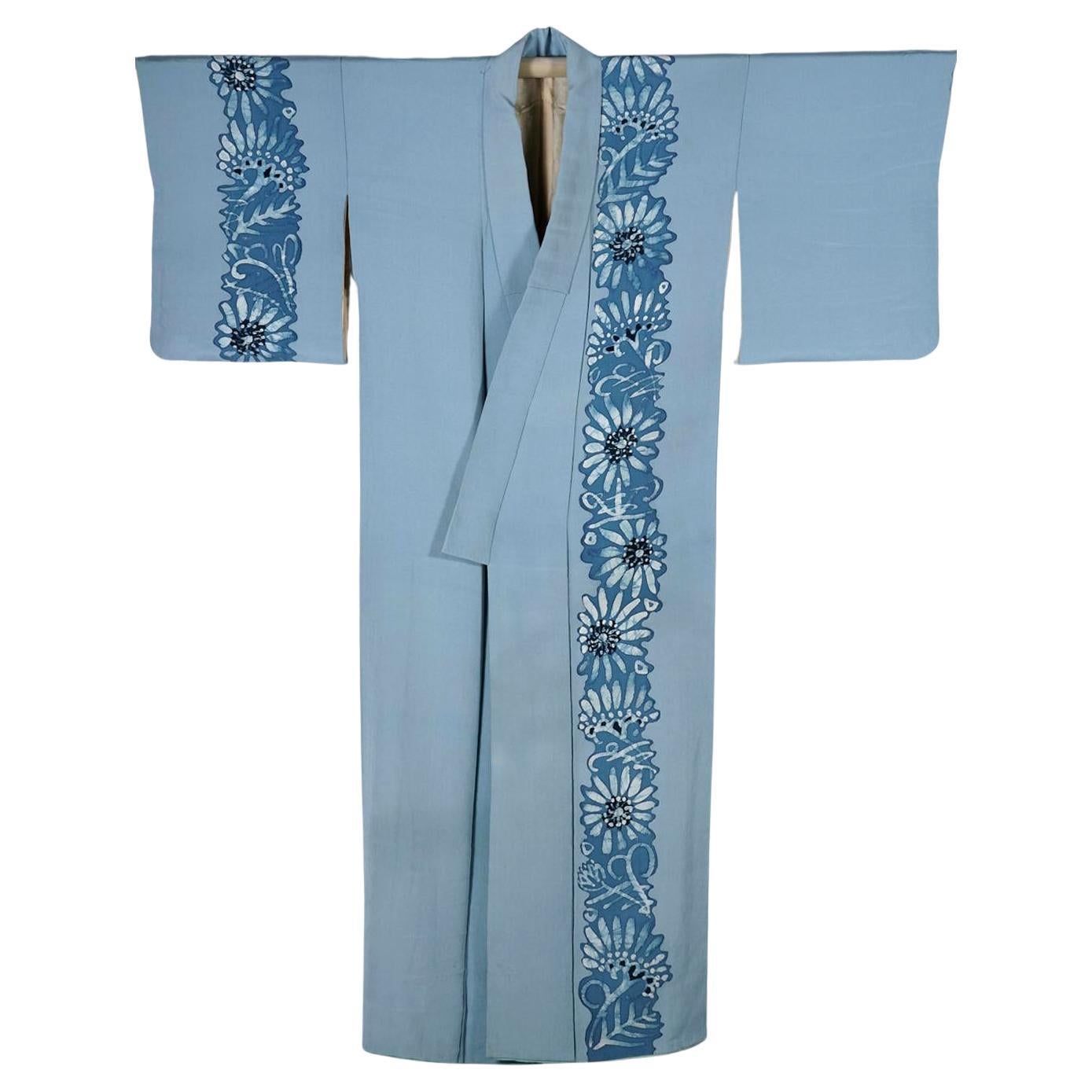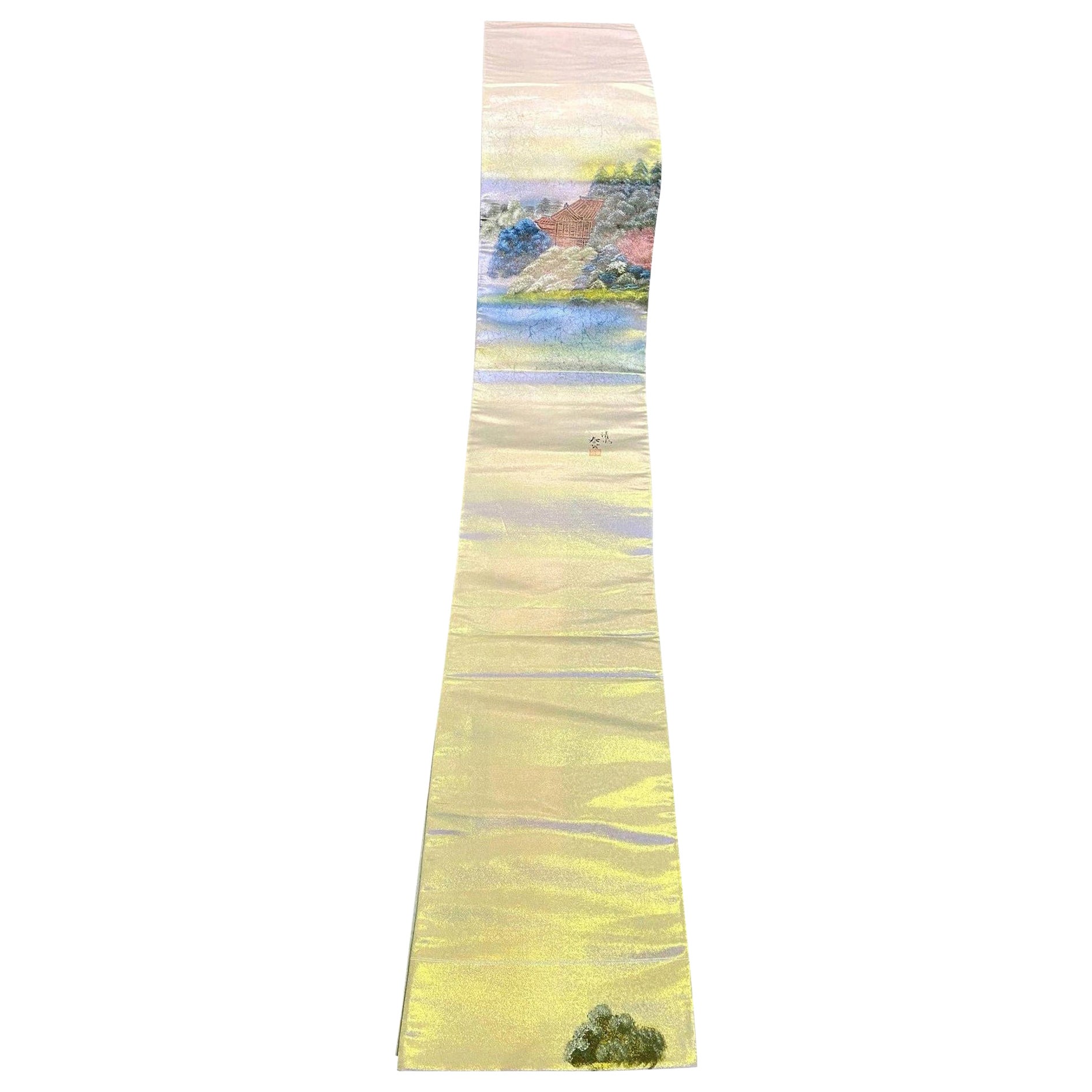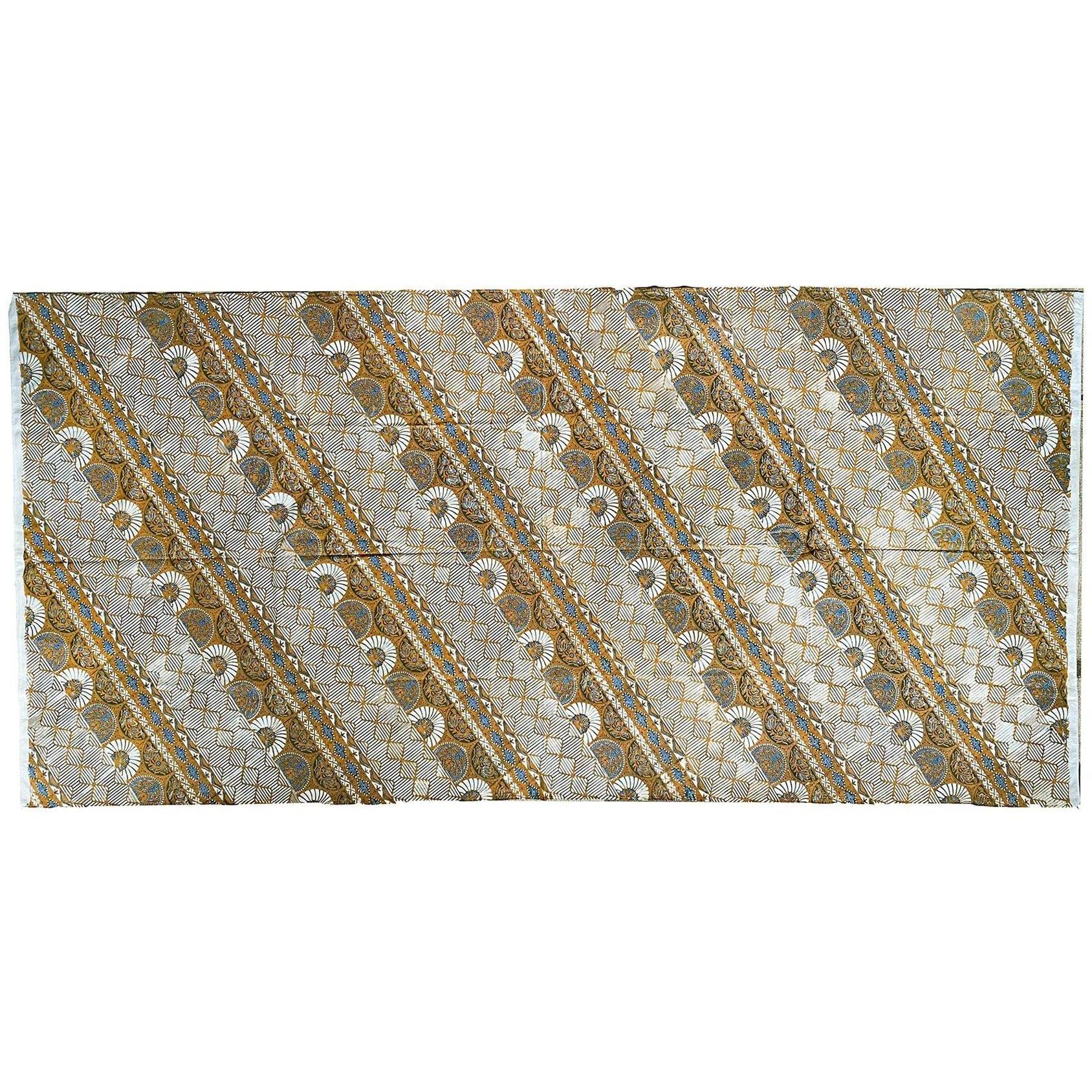Items Similar to Fine Japanese Couture Shibori Silk Furisode Kimono with Under Garment
Want more images or videos?
Request additional images or videos from the seller
1 of 20
Fine Japanese Couture Shibori Silk Furisode Kimono with Under Garment
About the Item
A spectacular Japanese silk kimono set with an outer furisode and an inner garment circa 1960-80s. The long sleeve furisode is of couture quality and made meticulously with the traditional shibori (tie dye) method. Small tiny pinches of fabric were individually tied and resistant died to create a striking design of blooming peony motifs in bright contrast red and white. The background was achieved in the same way but with black and white. The rendering of the design is superb in its stylized but realistic fashion. The composition considers a great deal on the positive and negative space as well as color play on the shadow. The Furisode has a thin silk inner lining with gradient red die on the edge. It is also equipped with a silk under garment of a complimentary pink hue with subtle variation in shade.
For a comparable Furisode with identical design but in blue, see item AK-RAK-2009-3-8 in the collection of the Rijksmuseum, Amsterdam, showing in the last picture. It is possible that these garments were from the same maker.
- Dimensions:Height: 67 in (170.18 cm)Width: 49 in (124.46 cm)Depth: 0.2 in (5.08 mm)
- Style:Modern (Of the Period)
- Materials and Techniques:
- Place of Origin:
- Period:
- Date of Manufacture:second half of 20th century
- Condition:Wear consistent with age and use. Very fine condition with little wear. Probably was barely worn.
- Seller Location:Atlanta, GA
- Reference Number:1stDibs: LU945034084872
About the Seller
5.0
Platinum Seller
These expertly vetted sellers are 1stDibs' most experienced sellers and are rated highest by our customers.
Established in 2006
1stDibs seller since 2010
478 sales on 1stDibs
Typical response time: <1 hour
- ShippingRetrieving quote...Ships From: Atlanta, GA
- Return PolicyA return for this item may be initiated within 2 days of delivery.
More From This SellerView All
- Elegant Vintage Japanese Silk Kimono with Shibori Band DesignLocated in Atlanta, GAA Japanese formal silk Kimono in a light blue color with striking floral design. The garment is hand-stitched from a crepe like silk and dated to circa 1940-60s. The garment is spars...Category
Mid-20th Century Japanese Japonisme Textiles
MaterialsSilk
- Japanese Indigo Kasuri Ikat Traveling CapeLocated in Atlanta, GAKnown in Japanese as Bozugappa (priest's raincoat), this cape-like garment was worn by the travelers in Japan circa late 19th century to early 20th century (end of Meiji period). Derived from the cape worn by the Portuguese missionary, who first arrived in Japan in mid-16th century, this type of cape was originally reserved for the Japanese military...Category
Antique 1890s Japanese Meiji Textiles
MaterialsCotton, Linen
- Vintage Japanese Silk Meisen Kimono with Geometrical DesignLocated in Atlanta, GAA vintage Japanese formal silk Kimono in an "ink green" color with striking geometrical design. The garment is hand-stitched Meisen kimono from a crepe l...Category
Mid-20th Century Japanese Japonisme Textiles
MaterialsSilk
- Vintage Japanese Formal Black Silk KimonoLocated in Atlanta, GAA vintage Japanese silk Kuro Tomesode Kimono, circa 1960s-1980s. Kuro Tomesode is a dress for married woman for the most formal occasions, equivalent of the evening gowns in the west...Category
Mid-20th Century Japanese Japonisme Textiles
MaterialsSilk
- Vintage Japanese Formal Black Silk Kimono with Pheonix EmbroideryLocated in Atlanta, GAA vintage Japanese silk Kuro Tomesode Kimono, circa 1950s-1980s. Kuro Tomesode is a dress for married woman for the most formal occasions, equivalent of the evening gowns in the west...Category
Mid-20th Century Japanese Showa Textiles
MaterialsSilk
- Japanese Art Deco Ikat Silk Meisen KimonoLocated in Atlanta, GAA well preserved Japanese Meisen kimono hand-sewn from woven Ikat Silk circa 1920-30s (Taisho to early Showa period). The kosode style kimono (small slee...Category
Early 20th Century Japanese Showa Textiles
MaterialsSilk
You May Also Like
- Embroidered Red and Green Japanese Silk Ceremonial Kimono, 1940'sLocated in Plainview, NYAn early 20th century exceptional Embroidered Japanese Ceremonial Kimono featuring marvelous handmade floral pattern in vivid colors including red, blue and green on gold. The interi...Category
20th Century East Asian Japonisme Textiles
MaterialsBrocade, Silk
- Japanese, Signed Stamped Silk Obi Sash Belt with Temple Shrine, Mid-1900sLocated in Studio City, CAA wonderful handmade vintage silk obi sash / belt featuring a Japanese temple - purportedly Kiyomizu temple in Kyoto, among the forest trees. Signed a...Category
Mid-20th Century Japanese Showa Textiles
MaterialsSilk
- Japanese Silk Textile by Iida Takashimaya CompanyBy TakashimayaLocated in Christchurch, GBAs part of our Japanese works of art collection we are delighted to offer this charming Meiji period 1868-1912 embroidery of a chin dog aside a spray of peacock feathers and by one of the most famous textile company’s of the period, the Iida Takashimaya company, the breathtaking and simply captivating detail of the silkwork demonstrates some of the finest possible stitching methods available at that time and not surpassed to this day, the silk picture is cushioned and housed within its original black lacquered wood frame and importantly bearing the original and scarce Iida Takashimaya factory label to the reverse, an absolute masterpiece from a golden period of textile production, this picture would light up the wall of any room particularly your Japanese themed space . Provenance : UK Collection . Featured in – 2020 Vision of an enlightened ruler exhibition – plate 39 Literature : There is little doubt that a major part of the phenomenon of Japanese works of art exploding onto the worldwide stage leading up to and during the Meiji period was bought about by the Textile manufacturers of Kyoto, the most recognized of which will undoubtedly be the Nishimura company, founded in Kyoto in 1670 as textile traders, It was the 12th generation manager Nishimura Sozayemon (1855-1935) aged just 17 and remarkably adopted into the family as the son of a Chinese scholar who took the company to its dizzy heights. As early as 1873 just one year into his tenure the company were exhibiting at expositions and even during that early period the company picked up significant awards and medals with recognition both nationally and overseas , particularly in Paris in 1878 , thereafter the factory moved to new premises in Kyoto , presumably having outgrown their original site , this move coincided with the building of the new Imperial palace in Tokyo where Nishimura were commissioned to provide 64 embroidered wall panels...Category
Early 20th Century Japanese Meiji Textiles
MaterialsSilk
- Japanese Edo Buddhist Monk Priest 7 Column Silk Brocade Kesa Ceremonial RobeLocated in Studio City, CAA wonderful, brightly coloured and somewhat rare fully intact Japanese Buddhist monk/ priest's Kesa ceremonial silk robe. Kesa (which came from the Chinese word "kasaya") robes have been handmade/handstitched by monks/priests as an act of devotion as ceremonial robes for centuries in various Asian cultures (Japanese, Chinese, Korean, Vietnamese, Indian, etc). The kesa is a rectangular garment designed to be worn over the left shoulder (see example image). The robes are made (often in a patchwork column pattern ranging from five, seven, nine or more pannels) specifically for fully ordained Buddhist monks, priests and nuns and are made from donations of exquisite textiles from wealthy patrons of Japanese Buddhist temples. The robes were used in daily ceremonies, temple gatherings, and private meditation. Antique Kesa robes...Category
Antique 19th Century Japanese Edo Textiles
MaterialsTextile, Brocade, Silk
- Japanese Buddhist Monk Priest 7 Column Silk Brocade Kesa Ceremonial Temple RobeLocated in Studio City, CAA wonderful, beautifully ornamented and somewhat rare fully intact Japanese Buddhist monk/ priest's Kesa ceremonial silk robe featuring various colorful birds in flight. Kesa (which came from the Chinese word "kasaya") robes have been handmade/handstitched by monks/priests as an act of devotion as ceremonial robes for centuries in various Asian cultures (Japanese, Chinese, Korean, Vietnamese, Indian, etc.). The kesa is a rectangular garment designed to be worn over the left shoulder (see example image). The robes are made (often in a patchwork column pattern ranging from five, seven, nine or more pannels) specifically for fully ordained Buddhist monks, priests and nuns and are made from donations of exquisite textiles from wealthy patrons of Japanese Buddhist temples. The robes were used in daily ceremonies, temple gatherings, and private meditation. Antique Kesa robes...Category
Mid-20th Century Japanese Showa Textiles
MaterialsTextile, Brocade, Silk
- Mid-20th Century Batik, Kain, Hip-Wrap Clothing Garment, JavaLocated in Point Richmond, CABatik, Kain, hip-wrap clothing garment, java, mid-20th century. Worn by both men and women. Black, blue, soga brown and ecru. Designs are applied using the wax resist-dye method. Typical of those made in Surakarta (Solo) one of the two central Javanese cities known for its highly developed batik art...Category
20th Century Javanese Mid-Century Modern Textiles
MaterialsCotton
Recently Viewed
View AllMore Ways To Browse
Modern Vintage Textiles
Retro Modern Textiles
Long Textiles
Garment Modern
Garment Modern Vintage
Garment Modern And Vintage
Fabrics From Japan
Vintage Japanese Fabric Fabric
Silk Kimono
Traditional Vintage Japanese Art
Silk Kimono Used
Japanese Furniture Maker
Japanese Furniture Makers
Retro Japanese Fabric
Textiles Red And White
Japanese Shade
Half Shade
Japanese Textile Design





